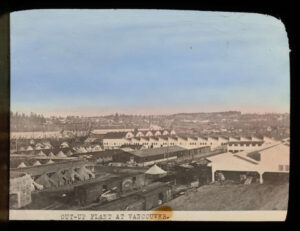
In 1914 Europe exploded into what was called the “War to end all wars”, which the USA had tried to stay out of. The war saw the introduction of many new weapons such as the use of ‘Aeroplanes’, which required using light flexible wood for the frames. The best wood to use was from Spruce trees located in the Pacific Northwest, from Northern California through Oregon and Washington, on up to Southeast Alaska, including BC. There was also much need for Fir lumber to build the structures of war, like trenches and railroads.
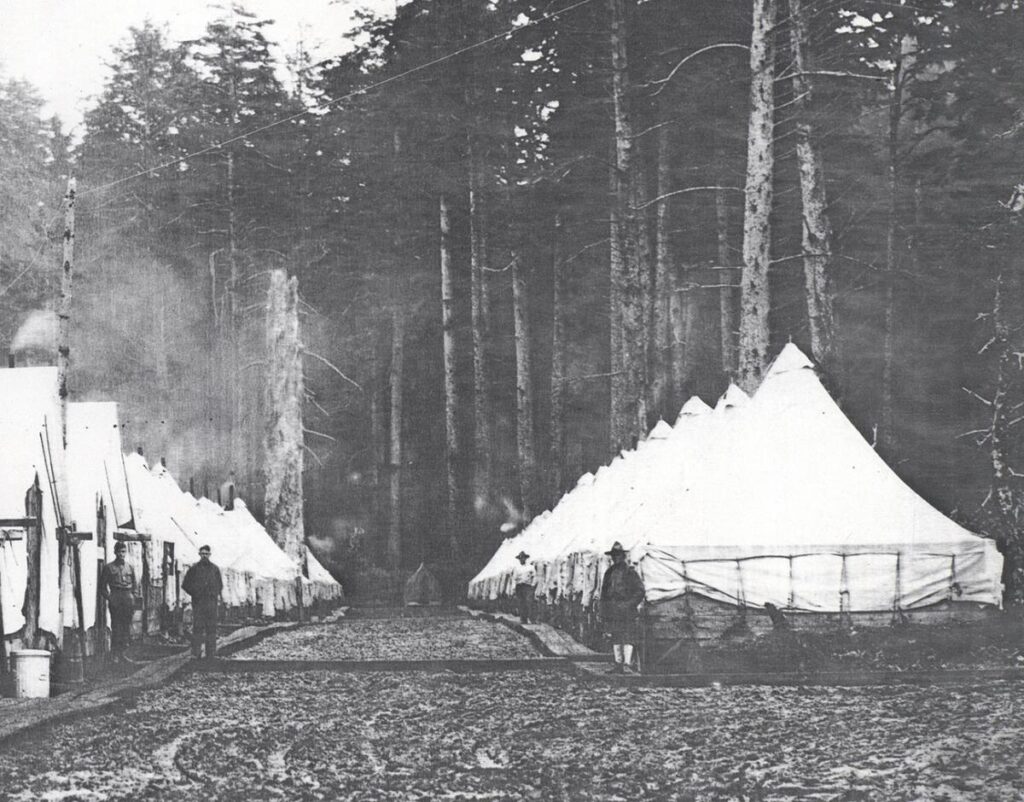
The production of the lumber needed was putting strain on the mills and logging operations of the Northwest and the United States entry into the war in 1917 exacerbated the situation by drafting many young men out of the woods. To add to the problems, was the lumber companies practice of maximizing their profits at the expense of their workers, resulting in a strike on July 16th, 1917, led by the IWW (Wobblies, [Industrial Workers of the World]) and the AFL (American Federation of Labor). The Unions were primarily striking for an eight-hour day, better working/living conditions and recognition of the union.
The workday in the Northwest forests mostly ran from dawn to dark and in the summer, workdays could be as long as sixteen hours. Wages were on average $40.00 to $80.00 per month, depending on the job. Injuries and even death were not uncommon, due to poor working conditions, and the speedups demanded by the companies. Even the food and lodging that was required to keep the loggers in the woods, at the best was, “nearly adequate to awful”. Little wonder why the IWW and AFL went on strike.
On May 7, 1917, Captain Brice P. Disque was summoned to DC to meet with General Pershing who sent him to study the ‘labor issue’ in the Pacific Northwest. Following his report in September, Disque was promoted to Lt. Colonel and was given the command of what was to be known as the “Spruce Production Division” and sent back to the Pacific Northwest with his headquarters in the Yeon Building in Portland Oregon.
Across the Columbia River, Fort Vancouver became the main operational center for receiving the 30,000 “Spruce Production Division” soldiers, training and disbursing those who would work in the 45- acre ‘Kiln dry’ mill being constructed on the fort’s ‘polo grounds’, and the others were to be sent into the logging camps throughout the Northwest forests.
Disque sending the Army into the woods to work along with the loggers, solved the “labor Issues” by the fall of 1917—he organized the Loyal Legion of loggers and Lumbermen (LLLL). This was an idea that Disque apparently adopted from Carlton Parker, who was the labor editor for the Cantonments Adjustment Commission, a civilian organization similar to the SPI.2 As early as December, 1917, Disque sent SPD Signal Corps officers out to camps, mills, and mill towns to enlist members for the LLLL. policies for stationing troops in logging camps and lumber mills were covered in an SPD policy statement, “the Employment of Soldiers in Private Camps and Mills.” Soldiers would be available after January 1, 1918, to work in the camps and mills. All lumber companies could apply for troop labor, but they had to meet some important requirements:
- 100 board feet of aircraft quality spruce shipped per man, per day
- Company Soldiers to receive the same pay as civilian workers
- Soldiers to be charged the same board fees as civilian workers
- Military sanitary regulations to be followed in camps
- One to four soldiers in each squadron assigned for “military reasons”
- Army to provide all medical attention for soldiers and civilians
- Recreation rooms to be provided in camps or mill bunkhouses
- Bathing facilities to meet military standards and inspections
- Latrines to meet military standards and inspections
- Bunkhouses to meet military’ standards and inspections
- Special rooms for drying wet clothing to be provided
- Officers to have separate mess and sleeping quarters
In December, this initial policy statement was supplemented by SPD Bulletin #3, which was a more detailed list of requirements for sleeping facilities, latrines, bathing facilities, messing facilities, and recreation rooms. By May of 1918, 62 logging operations in Oregon and Washington had soldiers working along side of their regular men.
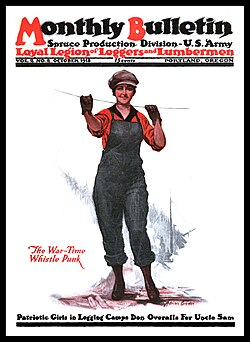
The most important element of Disque ‘s plan for labor peace was to institute the eight-hour day. This had been the core issue in the demands of the IWW and AFL in the July 1917 general strike. The lumbermen were adamant (or apoplectic) about the issue and would not concede to the unions. The eight-hour day was already becoming a trend in other industries by this time, however. For example, the federal government had mandated eight-hour days for all railroad workers through the Adamson Act in 1916. Disque brought about the eight-hour day in ’29 Hyman, Solders and Spruce, 66-80’.
In order to appease the lumber barons, the Army met in Centralia Washington with 16 of the largest barons and persuaded them to sponsor a new labor organization that became the “Loyal Legion of Loggers and Lumbermen” (LLLL) which required an oath to be taken:
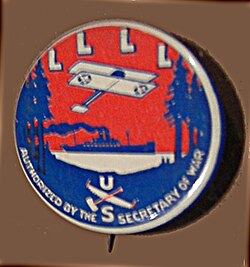
I, the undersigned, …do hereby solemnly pledge my efforts during the war to the United States of America and will support and defend this country against enemies foreign and domestic.
I further swear…to faithfully perform my duty toward this company by directing my best efforts, in every way possible, to the production of logs and lumber for the construction of Army airplanes and ships to be used against our common enemies. That I will stamp out any sedition or acts of hostility against the United States Government which may come within my knowledge, and I will do every act and thing which will in general aid in carrying this war to a successful conclusion.
Failure to take this loyalty oath could be met with firing from the companies and even arrest. From then on if you want a job, you had best join the LLLL. Into this fray came a young man who was drafted from California, Clarence Andrew Pursley, better known as ‘Dick’, this writers Grandfather.
Grandpa Dick was attached to the 32nd Spruces unit which was originally the 415th Aero (Construction) and were already stationed at Twin Washington. It was formed Dec 1917, at Vancouver Barracks also In Dec 1917, the unit was moved to Majestic, Washington, Puget Sound Mill & Timber (near Joyce, Washington). In April 1918, Grandpa Dick’s unit was already located in Twin, Washington, were then added to the 32nd. This unit’s location operational area was in the Olympic Peninsula, but his unit was not one of those moved with the many Spruce units used for the major work later in 1918 in Clallam County as they spent the war out of Twin. The 32nd Spruce stayed in the area for the duration of the War. In Nov 1918, they returned to Vancouver Barracks, and in Jan 1919, were demobilized there. His unit had 6 officers and 44 enlisted men.
While serving at Twin, Grandpa Dick was trained as a “Donkey Engineer” that brought the logs up out of the woods to the landing and then loaded onto the trains. From there, they went to Port Angeles where there was another mill being run by the army. Given that he had to only work 8 hours a day, he and his buddies had time to explore the forests and mountains of the Olympic Range.
Of course, while they did their exploring, they carried their .30-30 Winchester model 1894 lever action or some apparently had the 30 Remington rifles the Army’s SPD had provided them and stalked the “mowich” (deer). Now this writer isn’t quite sure if that ‘stalking’ was done during a hunting season or maybe a way to supplement their diet…
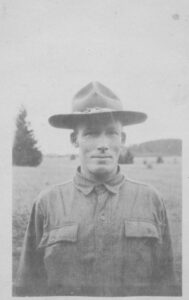
Being Irish and having a sense of humor, a lot of his photos from his trunk show him and his buddies clowning around.
At the left, this photo had written on the back to his soon to be wife, Florence Kennedy “1918- This is the one where I blew the whistle and they was afraid that the log was going to move. Look at Ed, he is about ready to fly! Keep all of these, XO”.
Following his discharge from the Army in 1919, Grandpa Dick went back to California, married his sweetheart, Florence Kennedy, then returned with her back to Twin Washington. He then got on the same “Donkey” he had worked on as an engineer, as if he’d never left. There on the “West End” of Clallam County they raised their family of my mother and her two brothers while working in the woods.

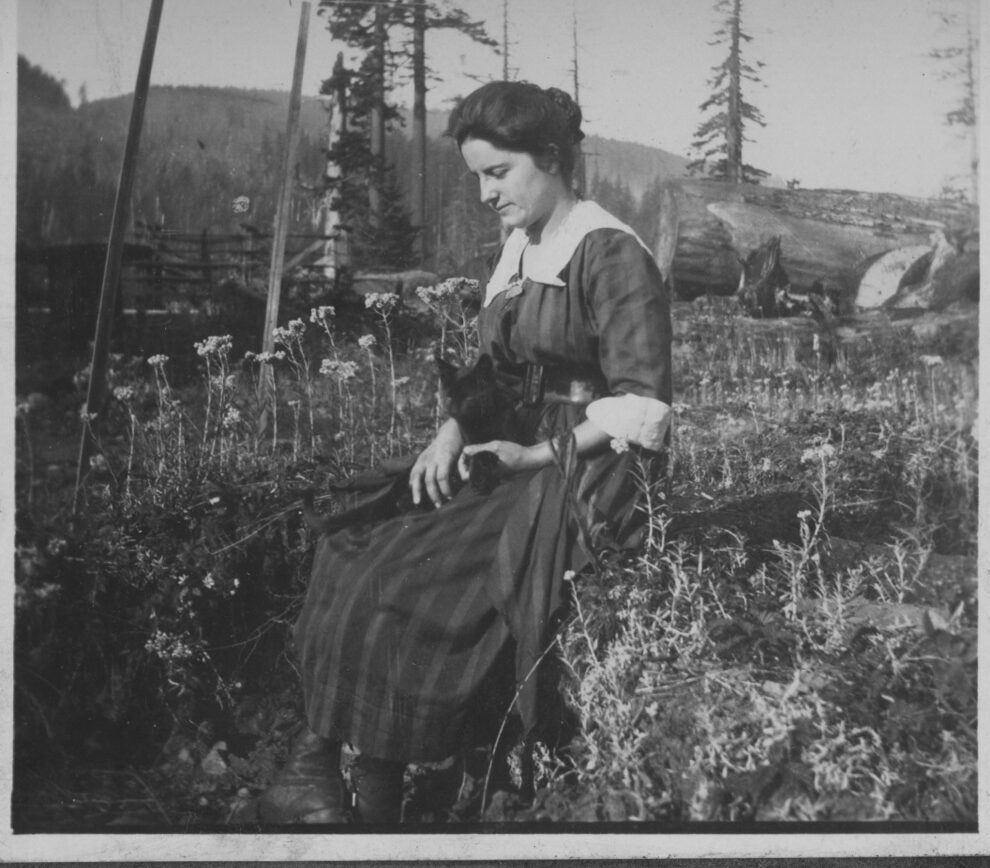
His uniform coat, Army trunk and photos that he took and sent back to what became this writers Grandmother, are with the National Park Service in the Spruce Production Division Museum located at Fort Vancouver.
CHECKOUT THE PHOTO GALLERY FOR MORE PHOTOS OF THE SPRUCE PRODUCTION DIVISION

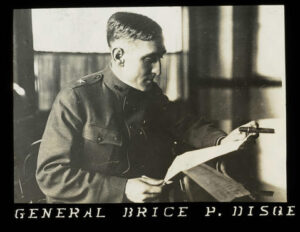
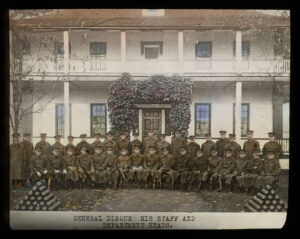
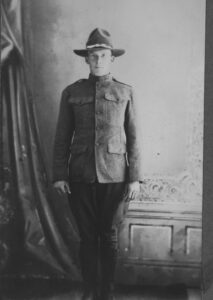
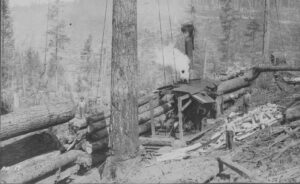
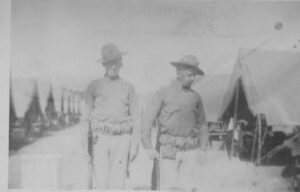
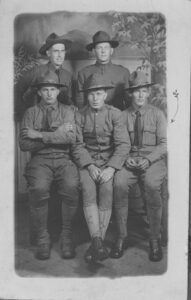
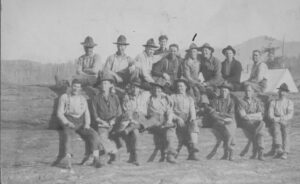
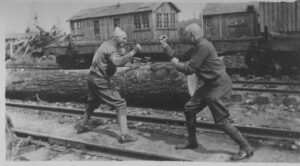
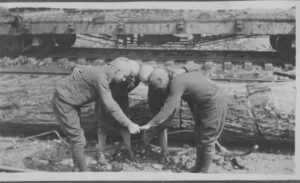
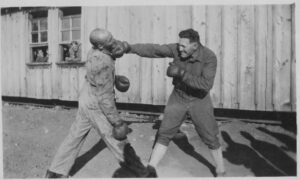
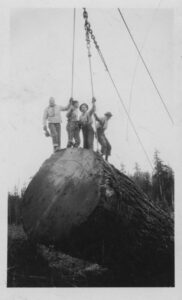
Jim, neat site, great photos, and great stories!!! Minor suggestions: airoplane is spelled aeroplane 30,30 Winchester is usually spelled .30-30 Winchester.
Let’s talk about stories some time.
Dennis